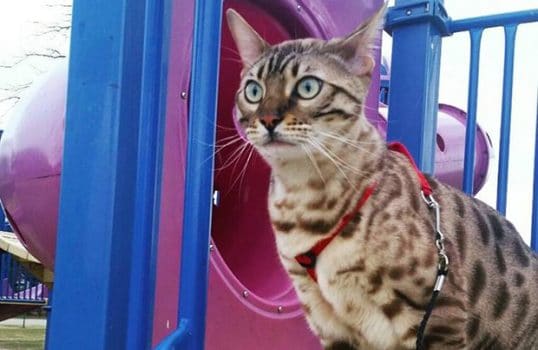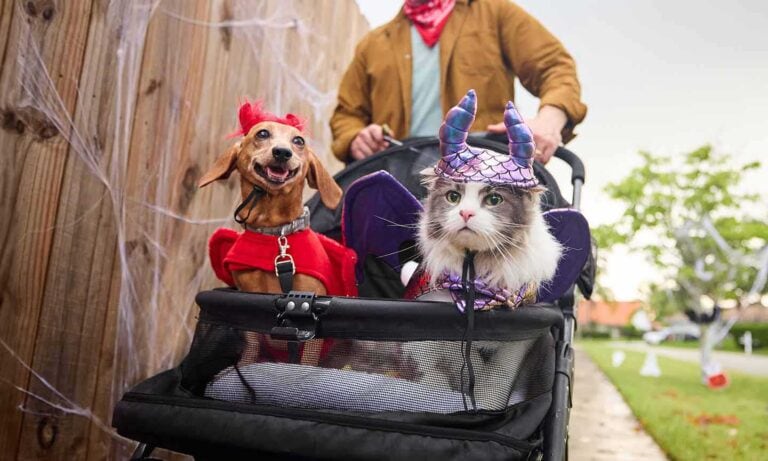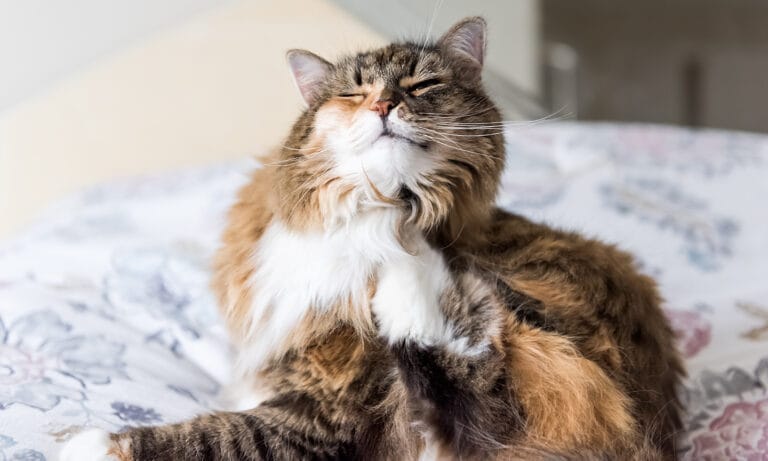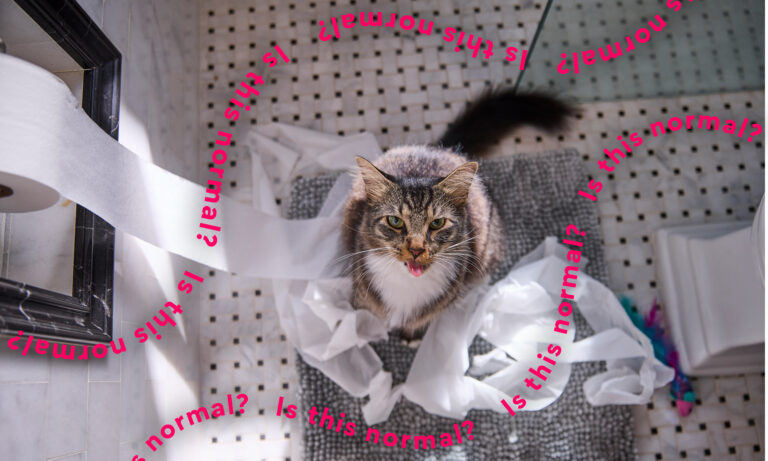When Melis Mandal set out to add a kitten to her household, she didn’t realize that she’d soon be moonlighting as a pet trainer. But after bringing home her Bengal Simba, now 2, she quickly realized that her new companion was exceptionally smart.
Motivated by the YouTube videos she found of cats performing tricks, she set out to teach Simba how to give her a kiss. Simba mastered the skill fairly quickly and soon, they were off and running.
We caught up with Mandal to learn how she trains Simba, what trick they’re working on next, and how training a cat is totally doable – “it just requires a bit more patience and dedication,” she says.
BeChewy: How did you end up with your cat, Simba?
Melis Mandal: I have always been fascinated by Bengals and started researching the breed online. I started taking to a breeder from Ohio, who I eventually ended up getting Simba from. I fell in love with him while videos on the breeder’s Facebook page along with looking at all of his photos. Besides being attracted to his personality in the videos, I loved his coloring. It was so unique to me and different from the brown Bengals you see a lot of. He is a Seal Mink Bengal. He was 16 weeks old when I bought him home.
PC: What inspired you to teach him to do tricks?
MM:The first few months after I got him, I noticed that when I put my face up to his to give him a kiss on the nose, he would actually reciprocate by leaning his head in too. This turned into his first trick.
Now, I don’t have to lean in for him to lean in as well. I get down to his level and say, “Gimmie a kiss,” and he’ll put his nose up to my mouth. Before getting a Bengal, I did a lot of research and came across a lot of articles and videos of Bengals doing tricks. I figured, this is a good start, let me teach him more. Bengals are very smart!

PC: How many tricks can he do?
MM:He can do five tricks: “gimme a kiss,” “stand,” “sit,” “fetch,” and “shake.” The next one I’m trying to teach him is “down,” to be hopefully followed by “roll over.”
PC: How did you learn how to teach him tricks?
MM:I saw some videos on YouTube and that gave me ideas on tricks, not necessarily how to teach a cat. I just made it up as I went along though. Every cat is different and you have to see what works best for the cat and for you.
PC: Walk us through Simba’s training process.
MM:I first started with a clicker but eventually dropped it for cat treats as rewards. For a trick that is a natural movement, like sitting, I would say, “sit” right before he sat. Then I would say “good boy” in a high pitched voice (he seemed to respond well to that tone) and give him a treat immediately after.
I taught him to “shake” after “sit” because he needed to be sitting for me to teach him to shake. Once he sat, I would say, “shake” and brush my hand along the back of his front paw to indicate to raise that paw. It took about a week for him to sit still and not walk away when I’d touch his paw. Finally, when he let me raise his paw up with my hand while I simultaneously said, “shake,” I would say “good boy” and give him a treat.
He can also play fetch. I throw one of his favorite toys and he goes after them. He did that pretty instinctually but then I worked to coax him to bring it back by saying, “come here Simba” in a soft, higher voice. And then gave lots of praise when he made his way over to me and dropped the toy. If he came back, I’d also give him a treat.
PC: How long did it take him to learn these tricks?
MM:Anywhere from one to three weeks depending on the trick and depending how committed I was within a time period. “Stand” was the hardest one for him to learn.

PC: How is training a cat different than training a dog?
MM:Cats are very particular and sometimes Simba would just not be in the mood or have the patience to train. With a cat, you just have to be more persistent and consistent, as in not getting discouraged if there is no progress. Sometimes you need an endless amount of repetition for your cat to finally follow through, or partially follow through.
PC: Tell us about taking Simba outside for walks on a leash. How did you get him used to that?
MM:I bought Simba a harness and put it on him while he was young and took him outside on the leash. From the beginning, he took to it very easily and naturally so there was no period of time where I had to get him used to it.
The part that took some time was getting him to walk in the direction that I want to walk. That’s where the treats and a lot of patience come in handy. The hardest part about walking him is not the actual leash and harness, but dogs. He is funny with them. Sometimes he will puff up like a cotton ball and with other dogs, he’ll get curious.
It makes me happy to know he’s enjoying the outdoors. I can tell because he’ll have his tail high up in the air and a little pounce to his step.
PC: How often do you take him out on a leash?
MM:In the winter, it’s random, whenever the weather is 40 degrees or warmer. In the summer, I’ll try to take him out every day just out in the backyard and twice a week I’ll drive him to a park or some trails. He’s an indoor cat with supervised outdoor time.
PC: Is there anything that you’ve had to troubleshoot with him being so smart?
MM:He knows how to open closet doors, so I don’t keep anything in closets anymore. The reason he started opening them was because I keep his harness and leash in the front door closet and initially he would go in there to give me a hint, like, “Hey, take me outside!”

Nicole Pajer is a freelance writer who lives in Los Angeles with her husband, energetic Doberman, and rat terrier.
Share:












